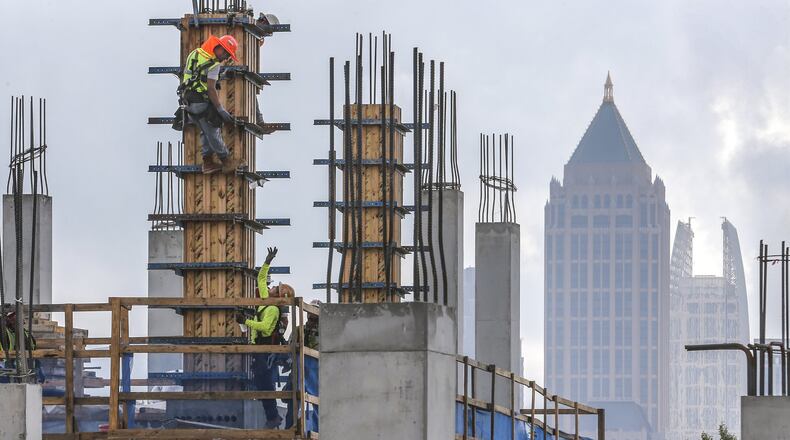By 2050, metro Atlanta will face enormous challenges as 2.9 million more people flock to an area already called home by twice that many residents.
A population forecast released Thursday by the Atlanta Regional Commission predicts the 21-county area will, in the next 30 years, grow older and more diverse as it basically absorbs the population of metro Denver.
More people means more traffic and a need for housing, two problems already frustrating metro Atlanta residents and leaders.
This amount of quick growth is usually only seen in places where people are being displaced by things like drought or war, said Joseph F. Hacker, a public management professor in Georgia State University’s Andrew Young School of Policy Studies.
“It’s going to press Atlanta for everything it’s worth,” he said. “This is enormously unusual, which means that the usual solutions will not make sense. And we may not be able to get out ahead of it.”
County-by-county coverage:
Mike Carnathan, head of research and analysis for ARC, said his team starts with national numbers and then forms a committee of local economists to dig deeper and make the data relevant to metro Atlanta by interviewing local leaders about future development. Because it’s been fine-tuned, the results can’t be compared to national data.
The fastest growing workforce sector will be health care and social assistance, mostly driven by the need to care for older folks, Carnathan said. An increase in those 75 or older creates another set of hurdles in transportation and housing because many elderly can’t get around like everyone else and required specialized homes.
READ | Georgia DOT pushes back plans for metro Atlanta toll lanes
Carnathan said the study looks at population change in the 21-county area that makes up metro Atlanta, from Spalding County south of Atlanta to Dawson County to the north. The study uses 2015, the last time ARC created a forecast, as a baseline.
Other key findings are that the area’s white share of the population will decrease from 47.5% to 31%, and the portion of residents age 75 and older will triple to 12%. Forecasters found that the area will remain a third black, making black residents the largest share. The Hispanic slice of the population pie will nearly double, from 12% to 21%.
And it’s not just the city. Forsyth County about 25 miles northeast of downtown Atlanta is predicted to have the fastest growth rate, nearly doubling in population. To the south, Henry County is set to grow by 70%. Forecasters also found that Gwinnett County is set to just barely edge out Fulton to become the most populous county in Georgia, with 1.48 million residents in 2050.
READ | E-scooters bring together some of Atlanta's most influential leaders
Rapid recent growth has caused artificially fast cycles, like gentrification in Atlanta’s Old Fourth Ward. Hacker said gentrification, the process of new residents displacing people who already live in an area, is natural and usually takes 30 to 40 years. Now in Atlanta? “We’re seeing gentrification occurring in two years,” he said.
“Supply and demand of housing has created this enormous leap in the cost of housing. We can’t build it fast enough … As they move forward, communities need to think about who they’re building for not who they hope they’re building for.”
There’s been a national trend of people moving to cities, and people have definitely found the Southern railroad town, one-time Olympic host and the hub of American pop culture. “Atlanta is really one of the last places in the United States where you can live in town and afford a house,” he said.
READ | GDOT moves ahead on Ga. 400 lanes without Alpharetta's big ask
Solutions for traffic and housing in North Fulton, choked with commuter-traffic throughout its more affluent communities, will look different from in southern Fulton, with a higher level of residents living in poverty and warehouses drawing commercial trucking.
People look to the Beltine, a Georgia Tech masters thesis turned 22-mile trail, as a solution. The Beltline has fallen short on its promised level of affordable housing, and experts fear the same for the planned parallel light-rail component.
“I have doubts about whether it’ll happen,” said GSU urban studies professor Jean-Paul Addie of the light rail plan.
He said a problem with metro Atlanta transportation is that, even if you build dense housing, people can’t walk from place to place.
“It’s no good having two or three pedestrian blocks surrounded by eight lanes of highway or disappear into sprawling single-family home subdivisions,” he said.
And then there’s the issue of making it affordable enough for Atlantans to live: “What is affordable and who defines what affordable is? That’s another political question as much as it’s a real estate or planning question … that locks in an uneven geography of development.”
The median price of a home sold in metro Atlanta in July was $260,000, up 86% from the post-recession trough in 2012, The Atlanta Journal-Constitution previously reported.
Addie said builders have a responsibility to build homes near transit stations.
READ | Study: People are building tons of family homes in South, North Fulton
“Transit-oriented development is something that ought to be on the minds of the ARC and Atlanta. It’s one of the historical failures of MARTA development … you see lots of transit stations sitting in oceans of car parking space,” Addie said.
Seeing the trend of Gwinnett becoming the state's most populated county, MARTA asked voters in March for the first time in nearly 30 years if residents wanted to pay an new sales tax for heavy rail and bus rapid transit services. Voters said no.
Finding ways to get people out of cars isn’t easy, experts say.
READ | MARTA working to add parking spots at 3 train stations
As Georgia State’s Chris Wyczalkowski, a professor who specializes in urban change, described it, cars are “your little box with air conditioning and someone talking to you on the radio.”
That’s tough to overcome. “It’s this chicken, egg thing. You don’t want to use the public infrastructure because it isn’t good enough, we don’t build more because people don’t use it. But we need this slow change,” he said.
And if Atlantans don’t prioritize other forms of travel over cars? Well, he said, remember Snowmageddon in 2014 when everyone took to the roads and got trapped in their cars after a dusting of snow?
“Think along those lines,” Wyczalkowski said.
Follow The Atlanta Journal-Constitution on Facebook and Twitter
Population forecast, by the numbers
Adding 2.9 million people to metro Atlanta’s 21-county area by 2050 means many changes. In 2015, there were 5.7 million. Here are some highlights from the Atlanta Regional Commission’s forecast:
- The share of white residents in the area will drop from 47.5% to 31%.
- The portion of Hispanic residents will nearly double, from 12% to 21%.
- Already, Atlanta is 33%, and it will remain that way even with the influx of newcomers.
- The slice of residents age 75 and older will triple to 12% by 2050.
- Forsyth County's population will almost double.
- Henry County will grow by 70%.
- Gwinnett County will narrowly edge out Fulton County for being the most populated in Georgia.
About the Author
The Latest
Featured





